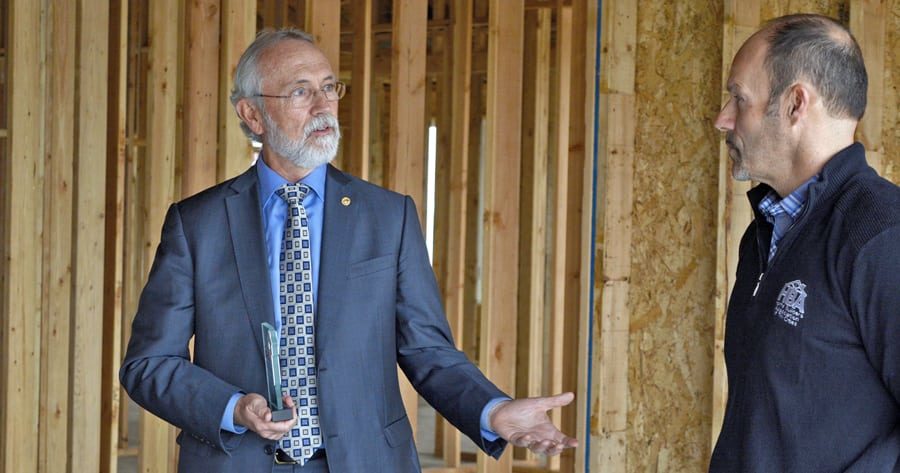
Home » Tri-City housing market boasts double-digit growth
Tri-City housing market boasts double-digit growth

December 15, 2016
The Tri-Cities appears to be beating national and state averages in the residential building market.
The region saw growth with new residential building permits up 26 percent over the same time period last year with more than 1,300 new single-family home permits.
Pasco recorded the highest number of permits and is experiencing growth similar to 2011, officials say.
Pasco issued 360 single-family permits through Nov. 30 with Kennewick following with 307. Richland issued 254 and West Richland 74.
This year also proved to be a good year for national growth. The number of building permits for single-family homes was up eight percent from January through September 2016 compared to the same period last year.
At the state level, there were 16,801 building permits issued for single-family homes over the same time period, an increase of 16 percent over 2015.
The year-to-date total for all building permits in Benton and Franklin counties totals more than $909 million.
Altogether, the single-family permits for 2016 through Nov. 30 totals more than $378 million in new growth spending in Benton and Franklin counties.
But while the economy is on the mend, Jeff Losey, executive director of the Home Builders Association of Tri-Cities, said he doesn’t expect the surge to continue in 2017.
“Depending on the interest rate increase that the feds are talking about—although it’s not supposed to be significant—we don’t believe the Tri-Cities will continue with (a similar) increase. Somewhere between 1,100 to 1,300 new residential permits seems to be what a good number is for the Tri-Cities, and we believe it will stay the same — which means growth and opportunity for jobs still,” said Losey, who has been the face of the association for more than a decade.
Losey was working in the insurance and financial fields when he became involved with the agency that supports the residential construction industry and related businesses. He started as a member before getting elected to the board in 2004 — but he never got a chance to serve.
“I would have started in 2005, but the executive director decided to retire, and the staff said, ‘Maybe you should consider applying,’” he said.
He said his financial background has been an asset. “Everything that touches the housing industry falls back to interest rates, labor and land. Having a mortgage background helps with understanding the industry and where it’s going,” said Losey.
Labor concerns
Labor is one of the key reasons the Tri-Cities housing market is unlikely to continue growing at the rate it saw this year, Losey said.
He said the construction work force lost more than a million workers across the country in 2008, and a third of those workers didn’t come back after the construction industry picked back up. Couple that with the industry continuing to lose workers to retirement and a shrinking labor pool and it takes a toll. (See story on page 24)
“A lot of expectations for kids is to get a four-year degree and go out and find a job, and most of those four-year degrees are not in the trades,” Losey said. “To a certain degree, it’s looked at as a step back than some of the white-collar jobs, which is unfortunate because it’s a rewarding industry for those who have a skilled craft.”
To get future employees excited about the construction industry again, Losey works with area schools. For instance, Walla Walla has a carpentry program for students and Pasco has a vocational building program.
“Those classes are critical to make sure that as our construction work force ages, we have people ready to fill those positions,” he said. “For those who are wired, who like to create, in construction, their work will be there for decades. It leaves a lasting impression.”
Educating students
The Building Industry Association of Washington, or BIAW, is also working to curtail the labor shortage seen not only in the Tri-Cities, but also across the state.
BIAW’s Jennifer Hayes said the association has made it a priority to work with legislators, businesses and schools to find solutions.
“BIAW is a member of the Washington team of the National Governor’s Association Policy Academy on Work-based Learning,” she said. “Washington is one of six states participating in the academy to help 16- to 19-year-olds learn about and pursue careers that use science, technology, engineering and math (STEM), as well as other industries that use these skills.”
Hayes said careers in the construction field offer good family wages, with the average carpenter earning $50,020 annually in Washington state. Drywall installers bring in roughly $54,000 annually, and plumbers earn an average of nearly $68,800, according to the National Association of Home Builders.
In 2017, BIAW will be involved with the Career and Technical Education Showcase, a competition that gives students — from high school to skills centers and colleges — an opportunity to show off their building expertise. Teens and young adults will create and build modest homeless shelters on the Capitol campus in Olympia.
“Ultimately our education system, which has minimized training for blue collar work and strongly encouraging students to become college prepared, must change and again provide things like shop classes and skill training,” Hayes said.
Available land
But even if a construction company has a full crew to work with, land availability also comes into play, and Losey said the Growth Management Act is a hindrance. The law was designed to identify and protect critical areas and natural resource lands by designating urban growth areas. When it was adopted by the Legislature in 1990, Losey said the goal was also to prevent urban sprawl. However, he believes the law artificially restricts the amount of available property.
“Put a circle around the city, and all the homes have to build inside that circle,” he said. “The problem is, the growth management hearings board, they’re all government appointed, so whatever decision they make, they only answer to the governor. So local control gets trumped by the will of the governor. So you take the city of Kennewick that wants to plan for the future, and they’ve targeted areas out by (Highway) 395 and Hildebrand, but because of the GMA, it doesn’t allow for them to (build there).
“Schools have been arguing to build outside of the urban growth boundaries too. You restrict the amount of land that’s available to build on and it causes the price to go up.”
The concern over available land extends well beyond Benton and Franklin counties.
In the Puget Sound region, Hayes said King County has seen a significant jump in home prices, increasing 14.5 percent in year-over-year prices, and that most urban markets will continue to experience regulatory based scarcity-driven appreciation—which ultimately affects a family’s ability to buy a home.
“By defining land as underutilized, it encourages the demotion of single-family homes for apartment complexes, running counter to the GMA’s own goal of preserving housing stock,” Hayes said, adding that BIAW will be working with legislators in 2017 to address the effects of the GMA at the local level. “The buildable land analysis needs to provide more real data to policy makers and be expanded beyond the six Western Washington counties to all GMA counties.”
Real Estate & Construction
KEYWORDS december 2016




